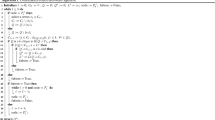Abstract
This chapter summarizes recent advances in identifying subgraphs with given properties on stochastic graphs, which generalize the classical maximum subgraph problems such as the maximum clique problem. When the vertices of a graph have stochastic weights, a risk-averse stochastic optimization approach is described that allows one to find a subgraph with the lowest risk that also satisfies a prescribed graph-theoretic property. Similarly to deterministic maximum weight subgraphs problems, the minimum-risk subgraph is found among minimal subgraphs, i.e., such subgraphs whose order cannot be increased without breaking the desired property. In the case when the graph’s edges are stochastic, a two-stage stochastic programming approach is described for constructing or detecting “resilient” or “repairable” structures, or such sets of vertices that (i) induce a subgraph of a given property, and (ii) upon a randomized change of graph’s topology can be “repaired” via addition and/or deletion of vertices so as to restore the desired property, and whose cardinality is maximized. Exact combinatorial (graph-based) branch-and-bound algorithms for both types of models are presented.
Similar content being viewed by others
References
Alekseev VE, Korobitsyn D (1992) Complexity of some problems on hereditary classes of graphs. Diskretnaya Matematika 4(4):34–40
Artzner P, Delbaen F, Eber JM, Heath D (1999) Coherent measures of risk. Math Financ 9(3):203–228
Babel L (1994) A fast algorithm for the maximum weight clique problem. Computing 52(1):31–38
Balas E, Xue J (1991) Minimum weighted coloring of triangulated graphs, with application to maximum weight vertex packing and clique finding in arbitrary graphs. SIAM J Comput 20(2):209–221
Bandelt HJ, Mulder HM (1986) Distance-hereditary graphs. J Comb Theory Series B 41(2):182–208. http://dx.doi.org/10.1016/0095-8956(86)90043-2, http://www.sciencedirect.com/science/article/pii/009 5895686900432
Bernoulli D (2011) Exposition of a new theory on the measurement of risk. In: The Kelly capital growth investment criterion: theory and practice. World Scientific, Singapore, pp 11–24
Birge JR, Louveaux F (1997) Introduction to stochastic programming. Springer, New York
Bollobás B (1998) Random graphs. In: Modern graph theory. Graduate texts in mathematics, vol 184. Springer, New York, pp 215–252
Bollobás B, Erdős P (1976) Cliques in random graphs. In: Mathematical Proceedings of the Cambridge Philosophical Society, vol 80, pp 419–427
Dashti H, Krokhmal PA (2017) A model for optimal reinforcement of error-and attack-resilient clusters in networks under uncertainty. In: Optimization methods and applications. Springer, New York, pp 97–117
Du B, Zhou H, Leus R (2020) A two-stage robust model for a reliable p-center facility location problem. Appl Math Model 77:99–114
Erdős P, Rényi A (1960) On the evolution of random graphs. Publ Math Inst Hung Acad Sci 5(1):17–60
Jiang H, Li CM, Manya F (2017) An exact algorithm for the maximum weight clique problem in large graphs. In: Proceedings of the AAAI Conference on Artificial Intelligence, vol 31
Krokhmal PA (2007) Higher moment coherent risk measures. Quant Financ 7(4):373–387
Kumlander D (2008) On importance of a special sorting in the maximum-weight clique algorithm based on colour classes. In: International Conference on Modelling, Computation and Optimization in Information Systems and Management Sciences. Springer, Berlin, pp 165–174
Li RH, Dai Q, Wang G, Ming Z, Qin L, Yu JX (2019) Improved algorithms for maximal clique search in uncertain networks. In: 2019 IEEE 35th International Conference on Data Engineering (ICDE). IEEE, Macao, China, pp 1178–1189
Matthews LR, Gounaris CE, Kevrekidis IG (2019) Designing networks with resiliency to edge failures using two-stage robust optimization. Eur J Oper Res 279(3):704–720
Miao Z, Balasundaram B, Pasiliao EL (2014) An exact algorithm for the maximum probabilistic clique problem. J Comb Optim 28(1):105–120
Östergård PR (2001) A new algorithm for the maximum-weight clique problem. Nordic J Comput 8(4):424–436
Pardalos PM, Xue J (1994) The maximum clique problem. J Glob Optim 4:301–328
Prékopa A (1995) Stochastic programming. Kluwer Academic Publishers, Berlin
Rysz M, Mehta S (2018) A two-stage stochastic optimization approach for detecting structurally stable clusters in randomly changing graphs. IEEE Trans Netw Sci Eng 6(4):671–683
Rysz M, Mirghorbani M, Krokhmal P, Pasiliao EL (2014) On risk-averse maximum weighted subgraph problems. J Comb Optim 28(1):167–185
Rysz M, Krokhmal PA, Pasiliao EL (2017) Detecting resilient structures in stochastic networks: a two-stage stochastic optimization approach. Networks 69(2):189–204
Rysz M, Pajouh FM, Krokhmal P, Pasiliao EL (2018) Identifying risk-averse low-diameter clusters in graphs with stochastic vertex weights. Ann Oper Res 262(1):89–108
Shimizu S, Yamaguchi K, Masuda S (2020) A maximum edge-weight clique extraction algorithm based on branch-and-bound. Discret Optim 37:100583
Shishebori D, Babadi AY (2015) Robust and reliable medical services network design under uncertain environment and system disruptions. Transp Res E: Logist Transp Rev 77:268–288
Vinel A, Krokhmal P (2014) Polyhedral approximations in p-order cone programming. Optim Methods Softw 29(6):1210–1237
Vinel A, Krokhmal P (2017) Mixed integer programming with a class of nonlinear convex constraints. Discret Optim 24:66–86
Yannakakis M (1978) Node-and edge-deletion np-complete problems. In: STOC’78: Proceedings of the 10th Annual ACM Symposium on Theory of Computing. ACM Press, New York, pp 253–264
Yezerska O, Butenko S, Boginski VL (2018) Detecting robust cliques in graphs subject to uncertain edge failures. Ann Oper Res 262(1):109–132
Zhang B, Peng J, Li S (2021) Minimax models for capacitated p-center problem in uncertain environment. Fuzzy Optim Dec Making 20:273–292
Author information
Authors and Affiliations
Corresponding author
Editor information
Editors and Affiliations
Rights and permissions
Copyright information
© 2023 Springer Nature Switzerland AG
About this entry
Cite this entry
Eshghali, M., Rysz, M., Krokhmal, P. (2023). Stochastic and Risk Averse Maximum Subgraph Problems. In: Pardalos, P.M., Prokopyev, O.A. (eds) Encyclopedia of Optimization. Springer, Cham. https://doi.org/10.1007/978-3-030-54621-2_720-1
Download citation
DOI: https://doi.org/10.1007/978-3-030-54621-2_720-1
Published:
Publisher Name: Springer, Cham
Print ISBN: 978-3-030-54621-2
Online ISBN: 978-3-030-54621-2
eBook Packages: Springer Reference MathematicsReference Module Computer Science and Engineering




